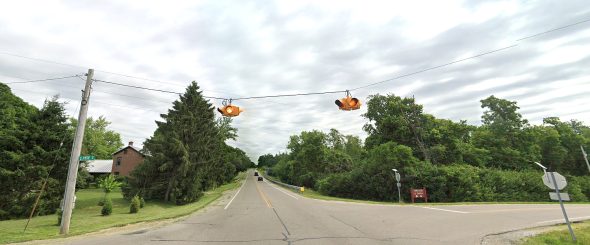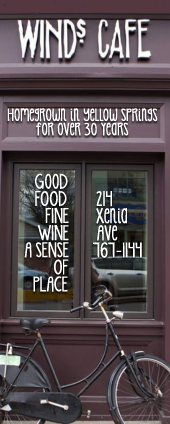
According to the Ohio Department of Public Safety, which keeps crash data on file for five years, data for the intersection revealed that 30 collisions, involving either one vehicle or multiple vehicles, took place there from Oct. 1, 2019–Oct. 31, 2024. (Photo: Google Maps)
Town Traffic | A closer look at Hyde Road and U.S. 68
- Published: March 13, 2025
TOWN TRAFFIC | This is the second in a series examining traffic flow and safety, and the ways people get around in Yellow Springs.
The intersection at U.S. 68 and East Hyde Road has long been considered by Yellow Springers as one of the most dangerous in or around the village. Vehicles traveling on Hyde Road are signaled — by both stop signs and an overhead flashing light — to yield to vehicles traveling on 68.
But they don’t always do so; in just the last six months, there have been eight traffic collisions at the intersection — all of which were caused by a vehicle failing to yield on Hyde Road.
The number of recent collisions has sparked concern from News readers, who have wondered: How bad is the intersection? And if it’s bad, what can be done about it?
By the numbers
Police Chief Paige Burge told the News via email this week that the intersection of 68 and Hyde is not within the YS Police Department’s jurisdiction — it’s located just outside of village limits, so the police jurisdiction falls to the Greene County Sheriff’s Office, and because 68 is a U.S. route, traffic-related incidents are handled Ohio State Highway Patrol.
Nevertheless, the YSPD is aware of the volume of calls that pertain to the intersection. Within the last 14 months, there have been 33 calls to Greene County dispatch about traffic-related incidents at 68 and Hyde — including traffic stops, traffic complaints such as reckless driving and crashes, with YSPD assisting in responding to six of those calls at the county’s request.
“While our department may not have jurisdiction over this particular intersection … I do acknowledge why this particular area may be of heightened concern, as it’s in the transition area between our village and the county road where speeds are greater entering and leaving our village,” Burge wrote.
In November last year, the News requested crash records for the intersection of U.S. 68 and East Hyde Road from the Ohio Department of Public Safety, or ODPS, which keeps crash data on file for five years. The five-year crash data for the intersection revealed that 30 collisions, involving either one vehicle or multiple vehicles, took place there from Oct. 1, 2019–Oct. 31, 2024. (According to data collected in a later request, there have since been two additional collisions at the intersection — one in November and one in December 2024.)
Of the 30 collisions recorded, 27 were caused by a vehicle traveling on Hyde Road that failed to yield at either the eastbound or westbound stop signs. The remaining three collisions include two involving two vehicles traveling on U.S. 68 near the intersection, and a third, single-vehicle collision with a guardrail. Twenty-nine of the recorded crashes took place between 8 a.m. and 7 p.m.; one occurred at 1 a.m.
Twenty-two of the 30 collisions — about 73% — involved only property damage, according to on-site assessments taken by Ohio State Highway Patrol officers. The remaining eight incidents — about 27% — involved either “possible” or “suspected” injuries, according to the assessments.
The number of collisions at 68 and Hyde is higher than other major intersections within village limits; for the same five-year period, there were four recorded one- or multiple-vehicle collisions at U.S. 68 and South College Street, five at Dayton-Yellow Springs and Enon roads, 11 at U.S. 68 and Limestone Street, 12 at U.S. 68 and Corry Street and 14 at U.S. 68 and S.R. 343/Cemetery Street. Notably, each of the above intersections — unlike 68 and Hyde — employs the use of a stoplight.
But it’s highly unlikely that 68 and Hyde will ever have a stoplight installed, based on state eligibility metrics set by the Ohio Department of Transportation, or ODOT, which holds the maintenance jurisdiction over the intersection. ODOT installs traffic signals based on traffic volume rather than the number of crashes that are recorded at an intersection.
Tom Mazza, a traffic studies engineer and Safe Routes to School coordinator with ODOT District 8 — which includes Greene County — said his department has fielded requests for a signal at 68 and Hyde “a half-dozen times” over the last several years. However, he added, based on existing traffic volume data, “the U.S. 68 and Hyde Road intersection will not meet” the required thresholds for installing a stoplight.
Specifically, U.S. 68 would need to meet a minimum traffic volume of 500 vehicles traveling in either direction within an eight-hour period. At the same time, there would need to be a minimum of 150 vehicles traveling in one direction on Hyde Road within an eight-hour period.
“It’s a pretty significant volume of traffic that’s required,” Mazza said. “I think the total traffic volume on Hyde Road throughout the day is not [150 vehicles], so it would be hard to meet these volumes.”
Changes for 68 and Hyde?
Though it’s not slated to receive a traffic signal, there could still be changes on the horizon for 68 and Hyde based on the number of collisions recorded there over the last several years.
Within the first three years of crash data collected by the News, there were a total of nine collisions caused by a vehicle failing to yield on Hyde Road and striking a vehicle traveling on U.S. 68 — five in the first year, three in the second, and one in the third.
Mazza said, on average, two or three “angle crashes” — that is, when one vehicle strikes another at an angle, typically at an intersection — is within typical annual state crash projections for a rural intersection like 68 and Hyde.
“We’re not seeing anything that’s outside of the ordinary [for the first three years],” Mazza said. “The intersection already has dual signage, we have the overhead flasher there, we put the LED stop signs up, and the speed limit is 45 miles per hour through there. … So there already have been a lot of low-cost, minor things that have been thought of for this location.”
However, within the final two years of data, Nov. 1, 2022–Oct. 31, 2024, there were 19 multi-vehicle collisions caused by a failure to yield — more than double the total number recorded in the previous three years.
Because the numbers have increased significantly over a two-year period at the intersection, Mazza said, it could receive more state scrutiny.
“I would say the crash trends we’ve seen the last two years are high enough now that this intersection is definitely of more interest to ODOT to look at with a little more detail,” he said.
Mazza said “more detail” would include an updated traffic count at the intersection — ODOT’s current data is “about three or four years old,” he said — and using that data to run a traffic signal warrant analysis
“Like I said, we don’t expect it to meet a signal warrant [threshold], but we’ll still check that,” he said.
Next, he said, ODOT would use the new traffic volume data to “analyze the predicted number of crashes … based on different types of intersection control.” In particular, how would 68 and Hyde function if it operated as a four-way stop, or as a roundabout?
Assuming these additional studies are conducted and find a need for a change at 68 and Hyde, Mazza said ODOT would look at applying for funding for an update to the intersection in August of this year.
However, the state tends to apply for funds based on a ranked list of roads and intersections that may need safety improvements. The current safety improvement priority list ranks up to the top 500 locations of a number of location types — including rural intersections, like 68 and Hyde — which are sorted “by highest expected fatal and all injury crashes per year/per mile,” according to ODOT.
“One of the things that list looks at is locations that have higher potential for safety improvement or that are seeing higher crashes than we would expect to see,” said Brianne Hetzel, a traffic engineer with ODOT. “This intersection just hasn’t been a ranked location in the past. … Really where we start looking at safety applications to pursue funding is based on that ranking list.”
Hetzel pointed out that, just down the road, the intersection of U.S. 68 and S.R. 235 — where a roundabout was installed last year — showed up as a ranked location “several times,” with ODOT trying the “low-cost, short-term counter measures” before pursuing funding to install the roundabout.
Nevertheless, Mazza said, if ODOT were to complete traffic studies and apply for funding for a change at 68 and Hyde this summer, it would be 2026 before project development would begin. And if, say, a roundabout were the way ODOT decided to go, it could take about three years to go through the planning and design process, and another year for construction.
“So it could be four years before it would actually get built,” he said.
Which is all to say: If changes are coming to 68 and Hyde, they won’t be coming any time soon. And, as ODOT Public Information Officer Kathleen Fuller added, there is a “public information process” ODOT goes through before beginning a project.
“So people will have their chance to comment,” she said. “There’s going to be a time where they can weigh in on it, and they’ll learn more about it before it ever happens.”
The News will follow up with ODOT this summer for more on what traffic studies the department conducted, what data was collected and whether ODOT intends to pursue funding for a safety improvement project.
The Yellow Springs News encourages respectful discussion of this article.
You must login to post a comment.
Don't have a login? Register for a free YSNews.com account.















No comments yet for this article.